Glimpses of hope amid escalating crises in the Middle East
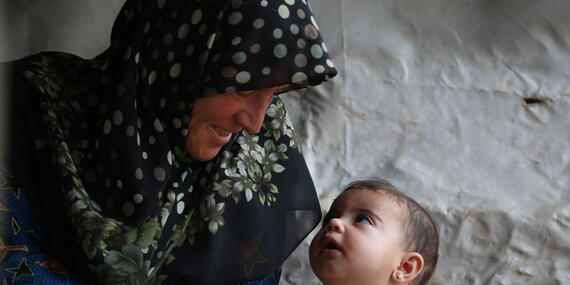
From deepening violent conflict to a series of deadly disasters, millions of people across the Middle East and North Africa region had their lives brutally upended in 2023.
But, in the face of unimaginable adversity, we also witnessed heartwarming humanity.
Here are 12 inspiring stories that gave us hope.
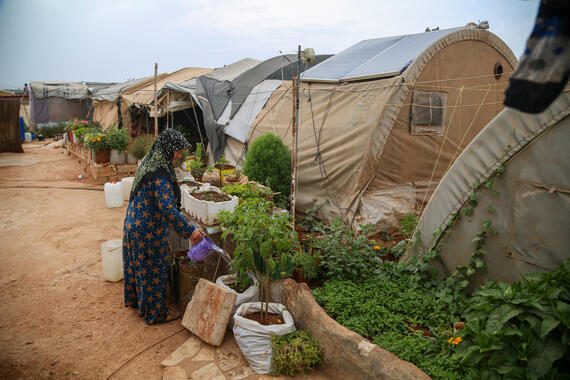
A garden in bloom
North-west Syria
Matra, 55, lives in a camp for displaced people in north-west Syria. Gardening reminds her of her village, and it helps her to forget her sorrow, fears and the conflict unfolding around her. In the winter, the smell of flowers from her garden gives her neighbours in the camp a much-needed respite from the smell of coal.
Camps rarely include gardens or gardening spaces, as they are only temporary shelters until displaced people can return home. However, there is a deep connection between many regional communities and creating gardens; people often take up gardening as a way to exercise some control over their immediate surroundings at a time when they seem to have lost control over broader events.

Determined to stay
West Bank, Occupied Palestinian Territory
Umm Saleh and her family live in central West Bank, but each day they remain in fear of settlers. She explained: “A few days ago, we found them sitting on the swing on our outdoor patio, and they threatened to kill us.”
Her son was injured by settlers this year, and her husband stays home most of the time to act as a deterrent. This has led to a severe financial strain on the family.
Violence by settlers, who are often armed, does not happen in isolation. It is one of multiple occupation-related practices that, combined with other actions, shape a coercive environment. The settlers exert pressure on Palestinians to leave their homes and communities. More than 1,500 Palestinians from the West Bank, most of them children, were displaced in 2023.
Umm Saleh and her family are just one of many families determined to stay. The humanitarian community is doing its part to support such families, with some partners extending legal support, emergency aid or protective presence. However, these efforts are often hampered by limited funding and constraints that make it difficult to provide protection under military occupation.
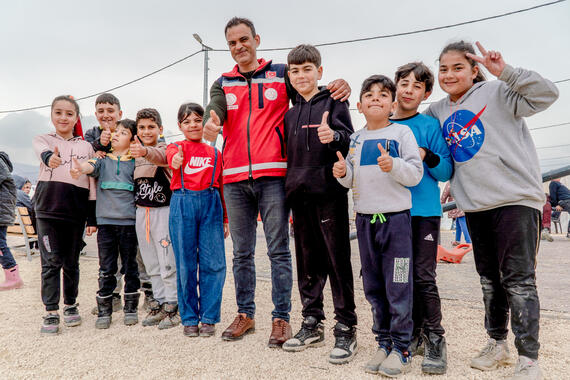
Starting a school from debris
Hatay, Türkiye
Kemal Haznedar is a deputy headmaster and survivor of the Türkiye/Syria earthquakes. He and his students salvaged furniture from the debris of damaged schools and brought it to a displaced people’s camp to run a school for children.
Natural hazards as destructive as the Türkiye/Syria earthquakes demand immediate and coordinated response efforts, especially when they hit areas affected by conflicts and displacement.
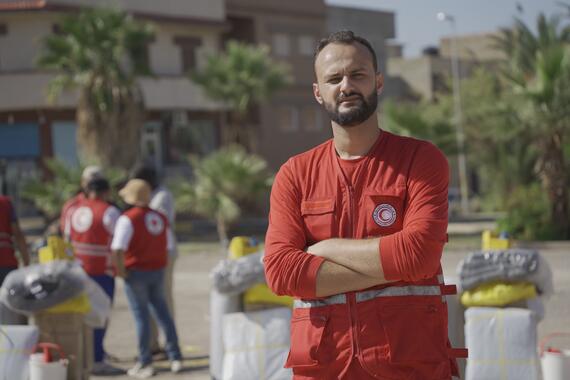
Surviving a tragic loss
Derna, Libya
Between 9 and 11 September 2023, Storm Daniel flooded and destroyed the coastal areas of north-east Libya and Derna city centre. An estimated 250,000 people were affected, more than 43,000 of whom were displaced. The death toll is estimated at 4,352, while more than 8,000 people are reported missing.
Hamedi, a Libyan Red Crescent volunteer, survived the storm. He explains:
“My mom called me. It was our last conversation. She told me to take care of myself and change into dry clothes so I wouldn't get cold. I saw people being swept away, calling out. Some were saying prayers, and I heard children calling for their baba [father]. I was searching for my house, but I saw nothing, not my house, not our entire neighbourhood. It had disappeared.”
Hamedi lost his entire family. Despite his tragic loss, he was in an ambulance early the following morning evacuating families. He continued helping affected families, coordinating the recovery of bodies, and providing urgent assistance and mental health and psychosocial support.
MENA is among the regions most vulnerable to climate risks. Climate change and the depletion of natural resources are becoming a threat multiplier in a context of weak governance, low preparedness and high sociopolitical instability. This is increasing population displacements, exacerbating the risks of violent conflict, and posing a significant threat to vital ecosystems and livelihoods.
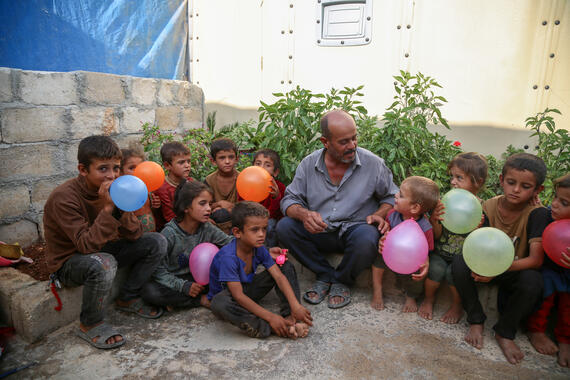
Finding family again
Idleb, north-west Syria
Khaled lives in a camp for displaced people in Idleb. After losing some of his family to the ongoing hostilities, he decided to share his tent with orphaned children. At the time of this photograph (October 2023), 14 orphans were living with him.
Since 5 October, more than 100 people have been killed in north-west Syria – almost 40 per cent of them children – due to shelling and other violence. More than 400 people have been injured.
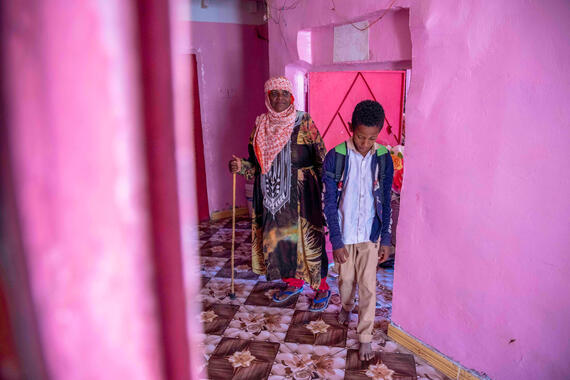
Restoring a home
Taiz, Yemen
2023 was the first year for Ghania and her family back in their original home after four years of displacement. They had fled their home in Al-Muzaffar district, in Taiz, to escape the conflict that had reached their neighbourhood. They lived in a rented apartment in Shameer, in the Taiz countryside. Their house in Al-Muzaffar was destroyed during their absence. The family had lost all hope of returning home.
Ghania’s smile was unmatched as she walked into the house with her nephew for the first time since their displacement. The home was restored by Building Foundation for Development, a local UNHCR partner. According to Ghania, the home looks even better than before.
Grateful to those who worked on the restoration project, Ghania says the intervention was a turning point in her life, alleviating the family’s suffering and giving them the opportunity to live a better, more stable and safer life.
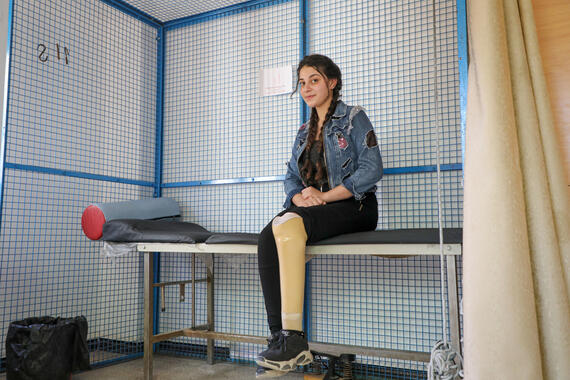
An angel gets new wings
Hama, Syria
Malak (“angel” in Arabic) lost her leg in 2021 to a landmine on her way home from school. After the tragic incident, she had to watch her friends go to school without her.
But humanitarian workers helped turn things around for Malak. Last year she received a prosthetic, psychosocial support and physiotherapy from Hand by Hand at its centre supported by the Syria Humanitarian Fund.
Malak was finally able to return to school. Her determination to get back on track is an inspiration.
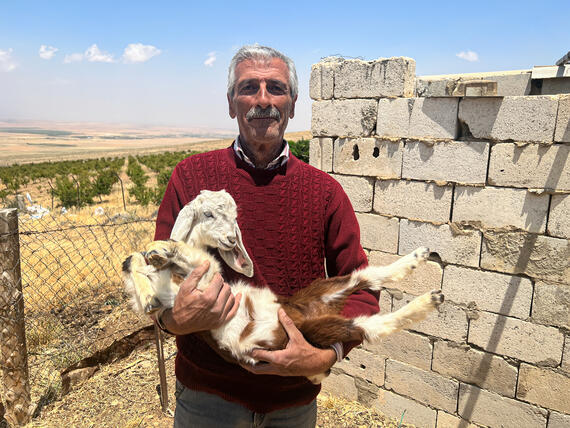
Securing a livelihood
Ras Baalbeck, Lebanon
George lost his job amid Lebanon’s current economic crisis. But cash assistance from the Lebanon Humanitarian Fund gave him and his family renewed hope for a better future.
The money has provided sustenance not only to his family but also to his farm. From olives to grapes to cattle, George’s farm in Ras Baalbeck is now thriving.
Lebanon’s unprecedented economic and financial crisis is affecting all residents, including Lebanese, Syrian and Palestinian refugees and migrants. Fears are now soaring due to the escalation of hostilities at Lebanon’s southern border.
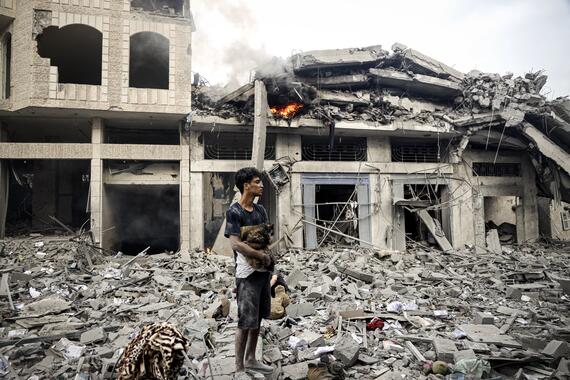
Rescuing a dear cat
Gaza Strip, Occupied Palestinian Territory
In the heart of the devastation in Gaza City’s Tal al-Hawa neighbourhood, 15-year-old Karim gazes at his destroyed neighbourhood, clutching his cat, Karaz.
The majority of the Gaza Strip’s population has been displaced, but for many, taking along their pets is not only an act of empathy or morality, but also one of love and companionship.
“I wouldn’t leave Karaz behind in the rubble,” said Karim. “She is my only friend now, and I will take good care of her.”
Pets are receiving increased attention in humanitarian responses. While humanitarian action is typically human-centric, the societal perception of pets as companions has led to countless stories of survivors, activists, displaced people and aid workers rescuing and protecting animals.
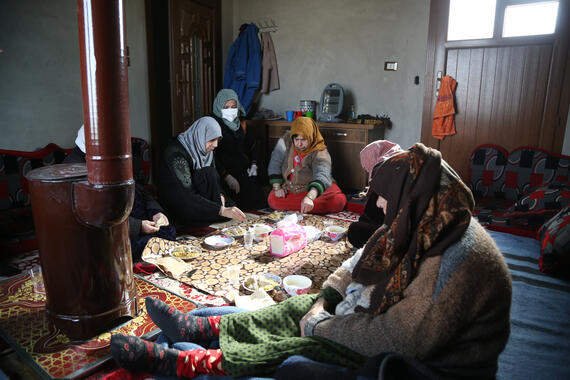
Caring for older people
Dar Al-Basheer Centre, north-west Syria
Several older women who live in camps and communities lost their caregivers during the conflict. But thanks to Dar Al-Basheer Centre, they have not been left behind.
The centre, in Maaret Masrin town, northern Idleb, is run by a local team of 12 women volunteers, including a nurse, who support the older women’s daily health and social needs. The centre currently does not have financial support other than voluntary donations from individuals.
Local volunteers play an important yet often overlooked role in humanitarian responses. And with increasing funding challenges, voluntary initiatives and donations are even more critical in humanitarian response.
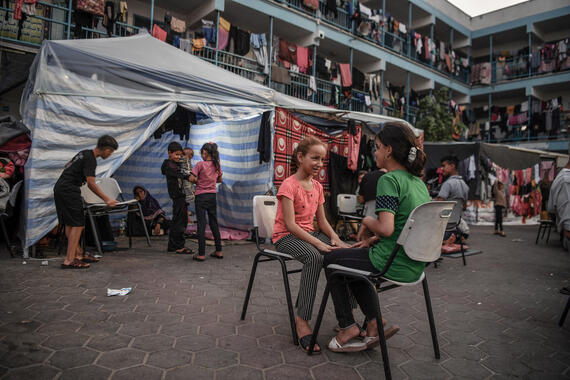
Restoring children’s smiles
Gaza Strip, Occupied Palestinian Territory
Children’s ability to smile and play despite the unprecedented suffering caused by the hostilities in the Gaza Strip gives us all hope.
According to UNICEF, the hostilities are catastrophic for children and families. Children are dying at an alarming rate – more than 5,000 have reportedly been killed and thousands more injured. They lack water, food, fuel and medicine. Their homes have been destroyed; their families torn apart.
With few toys left amid the intensified bombing and devastation, anything that helps children to play has been a beacon of hope.
Seeing these girls smile despite their situation reminds us of the importance of play for children – both as a necessity and a right.
Reviving hope
The demand for humanitarian assistance in the MENA region is expected to persist due to protracted conflicts, climate change and economic fallout. But as the Global Humanitarian Overview 2024 clearly demonstrates, financial resources for humanitarian action are shrinking at an alarming rate. In MENA, more than 40 million people need urgent support, according to humanitarian partners in the region.
You Can Help
You can support people in Lebanon, Occupied Palestinian Territory, North-west Syria, Syria and Yemen.
Please donate today.
